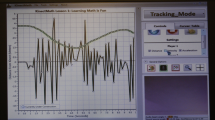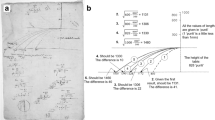Abstract
This paper focuses on the construction, development, and use of mathematical models by prospective science and mathematics teachers enrolled in a university physics course. By studying their involvement in an inquiry-based, experimental approach to learning kinematics, we address a fundamental question about the meaning and role of abstraction in modelling when such approaches involve students encountering and resolving experimental error. We use a “tensions” framework to explore the capability of learners to make necessary connections between abstract mathematical models and physical phenomena.
Similar content being viewed by others
References
Blum, W., Galbraith, P., Henn, H-W., & Niss, M. (Eds.) (2007).Modelling and applications in mathematics education: New ICMI studies series No. 10. New York: Springer.
Carrejo, D. (2004).Mathematical modelling and kinematics: Astudy of emerging themes and their implications for learning mathematics through an inquiry-based approach. Unpublished doctoral dissertation. University of Texas, Austin.
Cobb, P., Stephan, M., McClain, K., & Gravemeijer, K. (2001). Participating in classroom mathematical practices.Journal of the Learning Sciences, 10(1&2), 113–163.
Cohen, I. B. (1980).The Newtonian revolution. Cambridge, UK: Cambridge University Press.
Confrey, J. (1998). Voice and perspective: Hearing epistemological innovation in students’ words. In M. Larochelle, N. Bednarz, & J. Garrison (Eds.),Constructivism and education (pp. 104–120). New York: Cambridge University Press.
Confrey, J., & Doerr, H. (1994). Student modelers.Interactive Learning Environments, 4(3), 199–217.
Confrey, J., & Costa, S. (1996). A critique of the selection of “mathematical objects” as a central metaphor for advanced mathematical thinking.International Journal of Computers for Mathematical Learning, 1, 139–168.
Dear, P. (1995).Discipline & experience: The mathematical way in the scientific revolution. Chicago: University of Chicago Press.
delMas, R. C. (2004). A comparison of mathematical and statistical reasoning. In D. BenZvi & J. Garfield (Eds.),The challenge of developing statistical literacy, reasoning and thinking (pp. 79–95). New York: Springer.
Doerr, H., & English, L. (2003). A modelling perspective on students’ mathematical reasoning about data.Journal for Research in Mathematics Education, 34(2), 110–136.
Doerr, H., & Tripp. J. (1999). Understanding how students develop mathematical models.Mathematical Thinking and Learning, 1(3), 231–254.
Giere, R. N. (1999). Using models to represent reality. In L. Magnani, N. J. Nersessian, & P. Thagard (Eds.),Model-based reasoning in scientific discovery (pp. 41–57). New York: Kluwer Academic/Plenum.
Glaser, B. G. (1978).Theoretical sensitivity: Advances in the methodology of grounded theory. Mill Valley, CA: Sociology Press.
Glaser, B. G., & Strauss, A. L. (1967).The discovery of grounded theory: Strategies for qualitative research. New York: Aldine de Gruyter.
Halloun, I. (1996). Schematic modelling for meaningful learning of physics.Journal of Research in Science Teaching, 33(9), 1019–1041.
Hestenes, D. (1992). Modelling games in the Newtonian world.American Journal of Physics, 60, 732–748.
Hestenes, D. (1993).Modelling is the name of the game. Paper presented at the National Science Foundation Modelling Conference, Dedham, MA.
International Commission on Mathematics Instruction. (2003). ICMI Study 14:Applications and modelling in mathematics education [Discussion document]. Kassel, Germany: University of Kassel.
Justi, R. S., & Gilbert, J. K. (2002). Modelling, teachers’ views on the nature of modelling, and implications for the education of modellers.International Journal of Science Education, 24(4), 369–387.
Kaput, J. (1998). Representations, inscriptions, descriptions and learning: A kaleidoscope of windows.Journal of Mathematical Behavior, 17(2), 265–281.
Lehrer, R., & Schauble, L. (2000). Modelling in mathematics and science. In R. Glaser (Ed.),Advances in instructional psychology: Educational design and cognitive science (Vol. 5, pp. 101–159). Mahwah, NJ: Lawrence Erlbaum.
Lehrer, R., & Schauble, L. (Eds.). (2002).Investigating real data in the classroom: Expanding children’s understanding of math and science. New York: Teachers College Press.
Lesh, R., & Doerr, H. (Eds.). (2003).Beyond constructivism: Models and modelling perspectives on mathematics problem solving, learning, and teaching. Mahwah, NJ: Lawrence Erlbaum.
Mann, M. P. (1993). Grounded theory and classroom research.Excellence in College Teaching, 4, 131–143.
Matos, J. F., Blum, W., Houston, S. K., & Carreira, S. P. (Eds.) (2001).Modelling and mathematics education: ICTMA 9 - Applications in science and technology. Chichester, UK: Horwood.
McDermott, L.C. (1996).Physics by inquiry. New York: John Wiley.
National Research Council. (1996).National science education standards. Washington, DC: National Academy Press.
National Research Council. (2000).Strengthening the linkages between the sciences and the mathematical sciences. Washington, DC: National Academy of Sciences.
Otte, M. (1994). Is radical constructivism coherent? In P. Ernest (Ed.),Constructing mathematical knowledge: Epistemology and mathematical education (pp. 50–61). Bristol, PA: Falmer.
Petrosino, A. (2003). Commentary: A framework for supporting learning and teaching about mathematical and scientific models.Contemporary Issues in Technology and Teacher Education 3(3), 288–299.
Pollak, H. O. (2003). A history of the teaching of modelling. In G. M. A. Stanic & J. Kilpatrick (Eds.),A history of school mathematics (Vol. 1, pp. 647–672). Reston, VA: National Council of Teachers of Mathematics.
Sepkoski, D. (2005). Nominalism and constructivism in seventeenth century mathematics.Historia Mathematica, 32, 33–59.
Sfard, A., & Linchevski, L. (1994). The gains and the pitfalls of reification-the case of algebra.Educational Studies in Mathematics, 26(2–3), 191–228.
Stroup, W. (2002). Understanding qualitative calculus: A structural synthesis of learning research.International Journal of Computers for Mathematical Learning, 7(2), 167–215.
Taber, K. (2000). Case studies and generalizability: Grounded Theory and research in science education.International Journal of Science Education, 22(5), 469–487.
Van Driel, J. H., & Verloop, N. (1999). Teachers’ knowledge of models and modelling in science.International Journal of Science Education, 21(11), 1141–1153.
Van Driel, J. H., & Verloop, N. (2002). Experienced teachers’ knowledge of teaching and learning of models and modelling in science education.International Journal of Science Education, 24(12), 1255–1272.
Von Glasersfeld, E.. (2001). The radical constructivist view of science.Foundations of Science, 6, 31–43.
Wells, M., Hestenes, D., & Swackhamer, G. (1995). A modelling method for high school physics instruction.American Journal of Physics, 63(7), 606–619.
Woolnough, J. (2000). How do students learn to apply their mathematical knowledge to interpret graphs in physics?Research in Science Education, 30(3), 259–267.
Author information
Authors and Affiliations
Rights and permissions
About this article
Cite this article
Carrejo, D.J., Marshall, J. What is mathematical modelling? Exploring prospective teachers’ use of experiments to connect mathematics to the study of motion. Math Ed Res J 19, 45–76 (2007). https://doi.org/10.1007/BF03217449
Issue Date:
DOI: https://doi.org/10.1007/BF03217449




